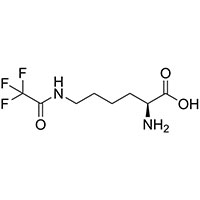Synonyms
L-Lysine, N6-(2,2,2-trifluoroacetyl)-
H-Lys(Tfa)-OH
(S)-2-Amino-6-pivalamidohexanoic acid
N6-(Trifluoroacetyl)-L-lysine
N-(Trifluoroacetyl)-L-lysine
Nepsilon-Trifluoroacetyl-L-lysine
Nepsilon-(Trifluoroacetyl)-L-lysine
N(6)-trifluoroacetyl-L-lysine
MFCD00037223
L-Lysine, N-(2,2,2-trifluoroacetyl)-
(2S)-2-amino-6-[(2,2,2-trifluoroacetyl)amino]hexanoic acid
QVYZ4MVXFFF &&L or S Form
Ne-Trifluoroacetyl-L-lysine
Product Description
Introduction:
N-Acetyl-L-lysine, commonly known as N-Acetyllysine or NAL, is a significant chemical compound with
diverse applications in the chemical industry. This product introduction aims to provide an overview of
N-Acetyl-L-lysine, covering its raw materials, production process, market trends, and the current status
of amino acids in the industry.
Raw Materials:
N-Acetyl-L-lysine is synthesized using L-lysine and acetic anhydride as the primary raw materials.
L-lysine, an essential amino acid, serves as the precursor for NAL synthesis. Acetic anhydride provides
the acetyl group necessary for acetylation.
Production Process:
The production process of N-Acetyl-L-lysine involves the following steps:
Step 1: Esterification reaction - L-lysine is reacted with acetic anhydride in the presence of suitable
catalysts and reaction conditions to form N-Acetyl-L-lysine. The reaction takes place in a solvent or
under solid-state conditions, depending on the specific manufacturing process.
Step 2: Purification and refinement - The resulting N-Acetyl-L-lysine is purified and refined using
techniques such as filtration, crystallization, and chromatography to achieve the desired level of
purity.
Market Trends:
The market demand for N-Acetyl-L-lysine has been steadily increasing due to its diverse applications
across various industries. Here are some key market trends:
Pharmaceuticals: N-Acetyl-L-lysine is utilized in the pharmaceutical industry. It is used as an
ingredient in the formulation of drugs targeting liver health, detoxification, and metabolic support. It
also finds applications in the development of amino acid-based supplements.
Cosmetics and Personal Care: N-Acetyl-L-lysine finds applications in cosmetics and personal care
products. It is used in skincare formulations due to its potential to promote skin hydration, improve
skin barrier function, and support the synthesis of collagen and elastin.
Chemical Research: N-Acetyl-L-lysine serves as a valuable compound in chemical research. It is utilized
as a building block in the synthesis of peptides, pharmaceutical intermediates, and specialty chemicals.
Its unique structure and functional groups make it useful for diverse synthetic applications.
Current Status of Amino Acids:
Amino acids play a crucial role in various sectors, including pharmaceuticals, food additives, animal
nutrition, and agriculture. The demand for amino acids continues to grow due to their diverse
applications and essential role in biological processes. Essential amino acids, such as L-lysine, are of
particular importance as they cannot be synthesized by the human body and must be obtained through diet
or supplementation.
Conclusion:
N-Acetyl-L-lysine, derived from L-lysine, holds significant value in the chemical industry. Its
production involves the combination of raw materials and precise manufacturing processes. The market
demand for N-Acetyl-L-lysine is driven by its applications in pharmaceuticals, cosmetics, personal care,
and chemical research. Amino acids, including L-lysine, continue to play a vital role in various
industries, and N-Acetyl-L-lysine maintains its position as a valuable chemical compound with diverse
applications.





